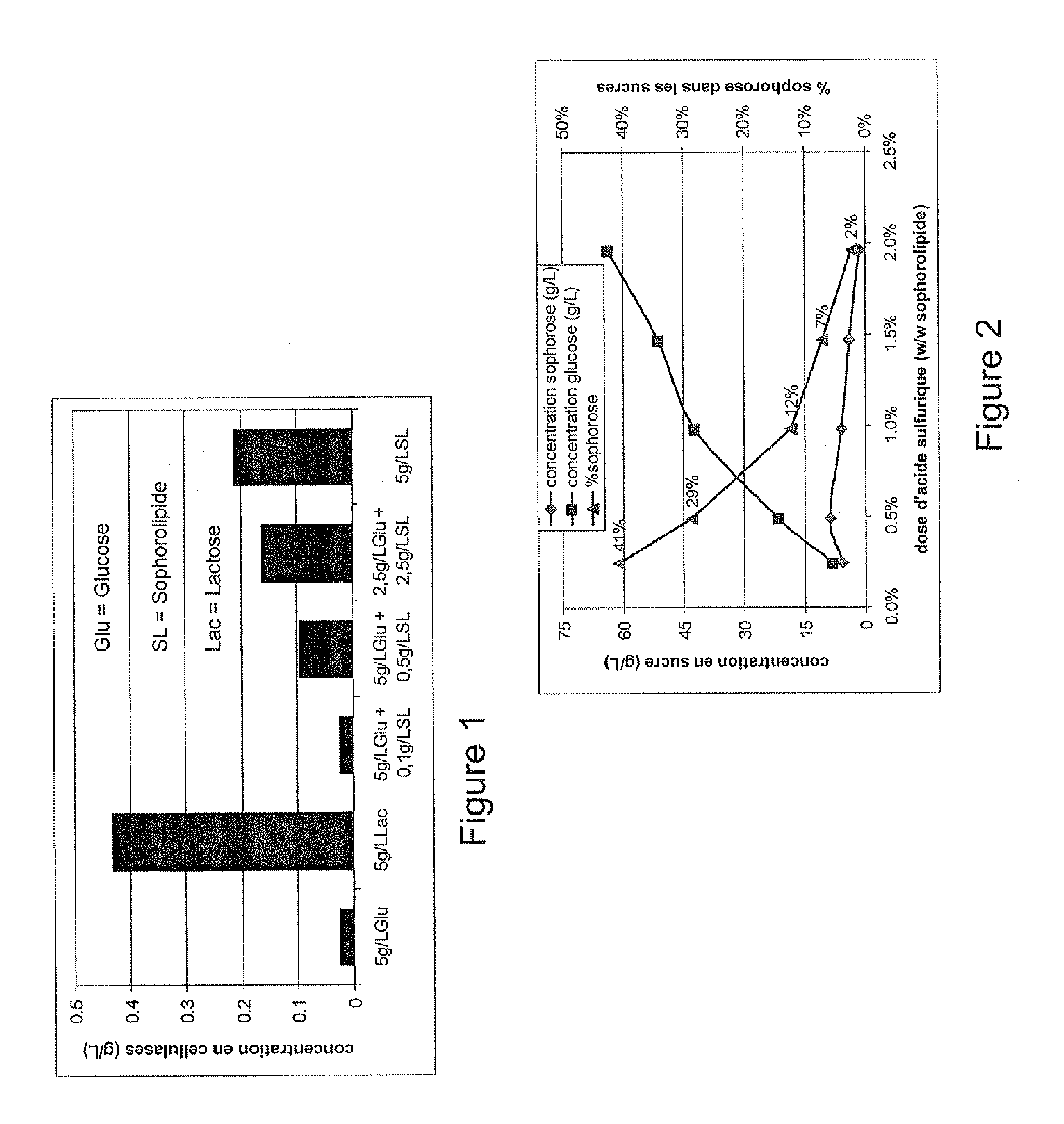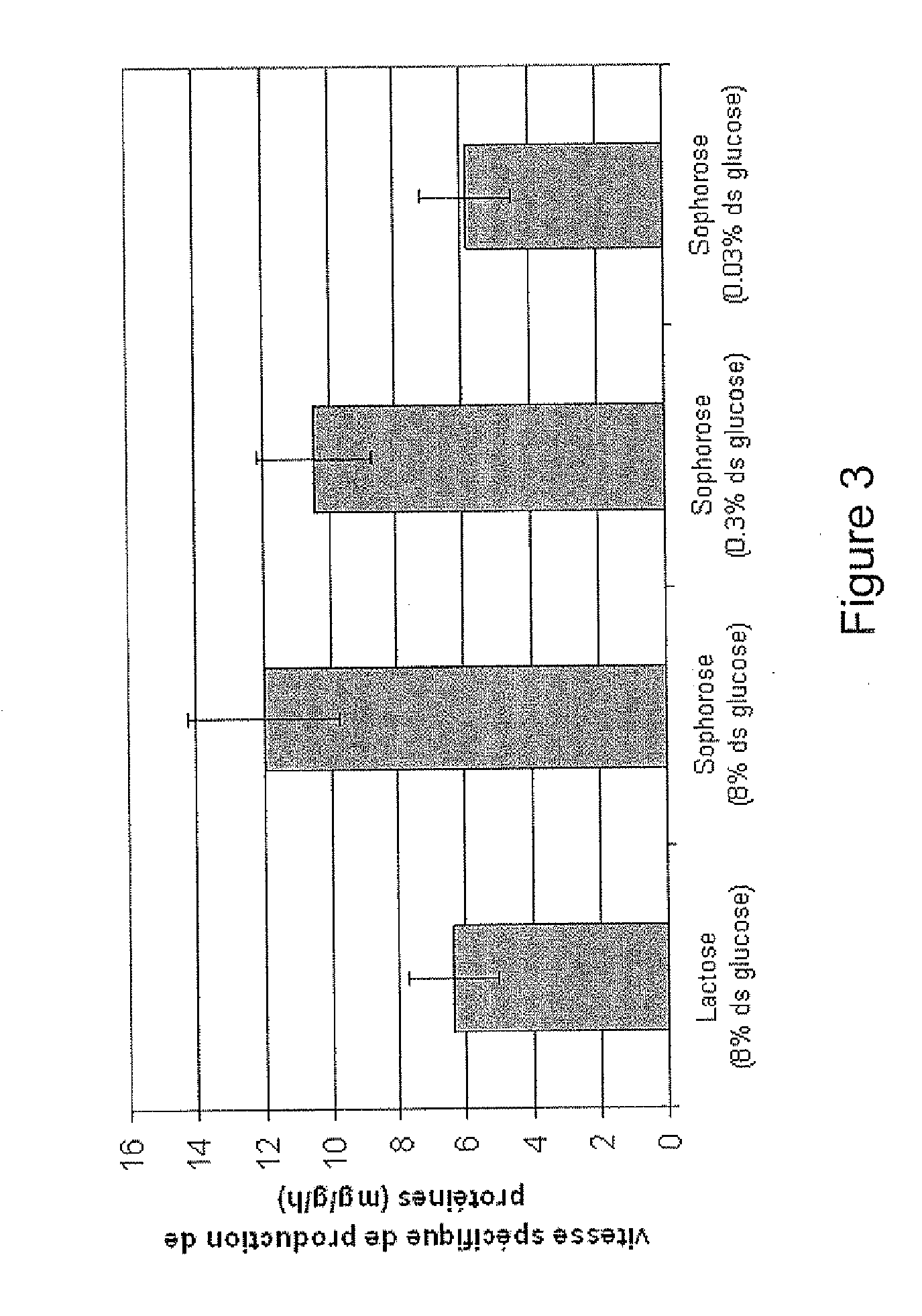Process for the production of sophorose starting from sophorolipids
- Summary
- Abstract
- Description
- Claims
- Application Information
AI Technical Summary
Benefits of technology
Problems solved by technology
Method used
Image
Examples
example 1 (
Not In Accordance With The Invention)
[0037]After growing T. reesei in a flask on 10 g / L of glucose and until exhaustion of the glucose, a medium was obtained containing 5 g / L of biomass (T. reesei cells). In this medium, injections of concentrated glucose solutions and sophorolipid solutions in the acidic form obtained from a Candida bombicola culture were carried out in order to obtain the desired quantities of glucose and sophorolipid as indicated in FIG. 1. Injections of glucose alone, lactose alone (conventional industrial inducer) and sophorolipid alone were also carried out, corresponding to control media.
[0038]After 20 h of incubation, the quantity of proteins (cellulases) produced in the various test media was analysed. The protein assay was carried out using the method by Lowry OH et al. (1951) [Protein measurement with the Folin phenol reagent. Journal of Biological Chemistry 193, 1, 265-275] using the DC Protein Assay kit (Biorad).
[0039]Referring now to FIG. 1, the result...
example 2 (
Optimization Of Conditions For Controlled Acid Hydrolysis Of Sophorolipids)
[0040]In test tubes, 1 mL of an aqueous sophorolipid solution (obtained from a Candida bombicola culture) in the acidic form, approximately 250 g / L, and concentrated sulphuric acid were mixed in order to obtain a concentration of sulphuric acid in the range 0.25% to 2% by weight of acid with respect to the weight of sophorolipid.
[0041]The test tubes were sealed with a hermetic stopper, then placed in a dry bath at 100° C. for 16 hours. The concentrations of sugars (glucose and sophorose) liberated during the hydrolysis were measured using HPLC.
[0042]Referring to FIG. 2, it can be seen that when the quantity of sulphuric acid was increased, the total liberation of sugars was improved (for the same hydrolysis period), however the mixture contained mainly glucose. In contrast, for the smaller quantities of sulphuric acid, i.e. in the range 0.1% to 1% by weight of sulphuric acid with respect to the weight of soph...
example 3 (
Controlled Sophorolipid Hydrolysis)
[0044]200 mL of a solution containing approximately 200 g / L of sophorolipids in the acidic form and 0.25% of sulphuric acid with respect to the weight of sophorolipid was prepared. This solution was set to boil in a retort, with stirring and under reflux, for 12 hours. The oily fraction containing the lipids resulting from hydrolysis was separated from the aqueous phase and the sugars (glucose and sophorose) liberated into the aqueous fraction were assayed by HPLC. The concentrations measured were 10.3 g / L of sophorose and 16.6 g / L of glucose, i.e. 38% by weight of sophorose in the liberated mixture of sugars.
Example 4 (Use Of Sophorolipid Hydrolysate To Induce The Production Of Cellulases By T. reesei)
[0045]After growing cells of T. reesei CL847 (Durand H. et al. (1988a) Classical and molecular genetics applied to Trichoderma reesei for the selection of improved cellulolytic industrial strains. In: FEMS Symposium n° 43: Biochemistry and Genetics o...
PUM
| Property | Measurement | Unit |
|---|---|---|
| Temperature | aaaaa | aaaaa |
| Temperature | aaaaa | aaaaa |
| Fraction | aaaaa | aaaaa |
Abstract
Description
Claims
Application Information
 Login to View More
Login to View More - R&D
- Intellectual Property
- Life Sciences
- Materials
- Tech Scout
- Unparalleled Data Quality
- Higher Quality Content
- 60% Fewer Hallucinations
Browse by: Latest US Patents, China's latest patents, Technical Efficacy Thesaurus, Application Domain, Technology Topic, Popular Technical Reports.
© 2025 PatSnap. All rights reserved.Legal|Privacy policy|Modern Slavery Act Transparency Statement|Sitemap|About US| Contact US: help@patsnap.com


